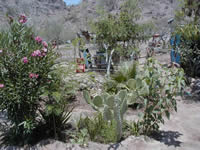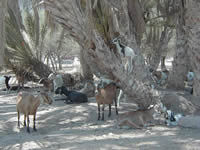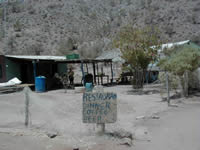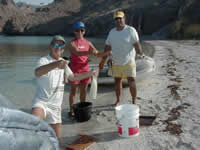| Volume
73
25 August, 2002
Agua Verde (25*31'N; 11*09'W)
Coming north
from Central America against the flow of southbound cruisers, we
collected nearly every Baja Guidebook known to man, and in the margins
of all the pages there are copious notes recommending anchorages,
dive sites, fishing holes, clamming spots, etc. Of all the places
talked about fondly, the one that recurred most often, was Agua
Verde. Even the guidebook itself relates the apocryphal tale that
if a boat were to sit in Agua Verde long enough, it would eventually
meet every cruising boat in the Sea. This led us to expect an anchorage
packed with boats, so it was a pleasant surprise to round into it
(June 20) and find only four, and those well spread out! One of
these was our friends Les and Diane of sv Gemini, and within an
hour of our arrival we were meeting all the others at a potluck
happy hour on the beach!
Thanks to an
inset in the coastline here, Agua Verde opens to the northeast.
The northernmost point is marked by the striking Roca Solitaire,
a 115' high finger thrusting straight up as if to say, "Here!
This is the number one spot!" The approach from the south is
through patches of reef arching out in a long curve to the white
lump of Isleta Marcial. Between these arms are three separate potential
anchorages, one protected from the winter north wind, one from the
summer southerlies and one in the center off the main beach. Having
moved far enough north to be clear of the nighttime Corumuels, we
chose to anchor off the beach, having been forewarned of dying squid
(and their odor) in the popular southern notch. The main beach is
about a half-mile long with just enough of a dune to conceal the
village in the plain behind it, behind which rise steep rugged mountains.
On the beach itself are scattered simple shelters of pole and thatch
presumably to protect the fishermen whose pangas are moored just
off the sand. There are also a couple of fairly sophisticated outhouses,
set up on blocks. (Our curiosity was piqued by these, but not quite
enough to actually check them out.)
 The
village behind the dune was a pleasant surprise, especially after
the bleakness of Evaristo. To start with there is more natural greenery
here than we had seen in a while, including clumps of shady palm
trees. There is a water supply, a spring we presume, that is piped
into town from the mountains, with the result that many houses have
gardens growing. You can't imagine how cheering a patch of green
or a splash of pink flowers is in this stark terrain. Taking advantage
of the flat plain, the town is laid out with a grandiose scheme,
with road tracks crossing in a pattern complicated enough to do
LA proud. The residential areas are split with one string of houses
along the foot of the mountains, and another dense cluster near
the far end of the beach amongst the palms. In between is the church,
the educational "facilities," a playground, and a spanking
new basketball court! There are about fifty families here, with
25 school-age children, and both primary and secondary education
are offered. Our guess is, however, that is still all by one teacher! The
village behind the dune was a pleasant surprise, especially after
the bleakness of Evaristo. To start with there is more natural greenery
here than we had seen in a while, including clumps of shady palm
trees. There is a water supply, a spring we presume, that is piped
into town from the mountains, with the result that many houses have
gardens growing. You can't imagine how cheering a patch of green
or a splash of pink flowers is in this stark terrain. Taking advantage
of the flat plain, the town is laid out with a grandiose scheme,
with road tracks crossing in a pattern complicated enough to do
LA proud. The residential areas are split with one string of houses
along the foot of the mountains, and another dense cluster near
the far end of the beach amongst the palms. In between is the church,
the educational "facilities," a playground, and a spanking
new basketball court! There are about fifty families here, with
25 school-age children, and both primary and secondary education
are offered. Our guess is, however, that is still all by one teacher!
Perhaps because
of the steady flow of cruisers through Agua Verde, there is definitely
a perkier attitude about strangers walking through. Everyone says
"Hola" or "Buenos dias," as we pass. There are
also some entrepreneurial efforts going on, and we patronized every
one we could find. There is  cheerful
Cecilia, who make tortillas by the kilo, while you wait in the shade
next to their bed in the front yard, fully made up, complete with
stuffed animals! Then there's Maria whose tienda has an amazing
selection of things, including fruit and vegetables (providing,
of course, you get there on the right day!) much of which is hung
in plastic bags from the rafters (which are very low...mind your
head, Gwen!) She explained that the restocking takes place at night
when the produce has a better chance of surviving the 40 mile ride
(over a very rough road) cheerful
Cecilia, who make tortillas by the kilo, while you wait in the shade
next to their bed in the front yard, fully made up, complete with
stuffed animals! Then there's Maria whose tienda has an amazing
selection of things, including fruit and vegetables (providing,
of course, you get there on the right day!) much of which is hung
in plastic bags from the rafters (which are very low...mind your
head, Gwen!) She explained that the restocking takes place at night
when the produce has a better chance of surviving the 40 mile ride
(over a very rough road)  in
the back of her husband's pick up truck! The little "Bar/Restauran"
(sic), with one picnic table under the thatch roof and cooking done
on a 50-gallon drum, provided some very cold refreshment, but only
enough for one round when the cruisers descended! Block ice only
goes so far, and electricity is limited to what a few solar panels
here and there can provide. We were even able, on the far side of
town, to buy a big wheel of freshly made goat cheese (which was
great in quesadillas made from Cecilia's tortillas!) from a fairly
active goat farming operation. Last Thanksgiving, a bunch of cruisers
celebrated the holiday with a goat roast. We note this year that
the goat farmer has added several turkeys to his flock. Now there's
a man that responds to consumer needs! in
the back of her husband's pick up truck! The little "Bar/Restauran"
(sic), with one picnic table under the thatch roof and cooking done
on a 50-gallon drum, provided some very cold refreshment, but only
enough for one round when the cruisers descended! Block ice only
goes so far, and electricity is limited to what a few solar panels
here and there can provide. We were even able, on the far side of
town, to buy a big wheel of freshly made goat cheese (which was
great in quesadillas made from Cecilia's tortillas!) from a fairly
active goat farming operation. Last Thanksgiving, a bunch of cruisers
celebrated the holiday with a goat roast. We note this year that
the goat farmer has added several turkeys to his flock. Now there's
a man that responds to consumer needs!
 But
the best part about Agua Verde was the fishing. The waters of the
bay were so dense with bait fish that the pelicans, cormorants and
sea gulls were kept feeding all day into the night (full moon!).
In the late afternoon, most of the cruisers went out by dinghy with
fishing gear in hand in hopes of a fresh supper, so of course the
2Cs followed suit. Despite the special rods we'd acquired for dinghy
fishing back in the Caribbean, we have done very little reef fishing,
and you can guess how little reward our small efforts had produced.
Well, Agua Verde can go down as the place where all that turned
around. We are now fishing fiends. Nothing like success to breed
interest. But
the best part about Agua Verde was the fishing. The waters of the
bay were so dense with bait fish that the pelicans, cormorants and
sea gulls were kept feeding all day into the night (full moon!).
In the late afternoon, most of the cruisers went out by dinghy with
fishing gear in hand in hopes of a fresh supper, so of course the
2Cs followed suit. Despite the special rods we'd acquired for dinghy
fishing back in the Caribbean, we have done very little reef fishing,
and you can guess how little reward our small efforts had produced.
Well, Agua Verde can go down as the place where all that turned
around. We are now fishing fiends. Nothing like success to breed
interest.
The objective
of the first outing was squid, under the tutelage of Les and Diane
of sv Gemini. Apparently, this is mating season and squid (the preferred
food of the whales) are everywhere. Let me tell you, squid fishing
is kind of exciting. To start with, these things are not the little
"ballerinas" we see in the Caribbean. These things are
big. Like 18 inches! When they hit the lure (and actually it is
more a question of the lure snagging in the tentacles!), they give
a very satisfactory fight on the rod (first time I've even understood
the concept). But it's when you get them to the dinghy that things
get exciting, especially when you don't have a net! They have unlimited
supplies of ink it seems, which they squirt like mad as they're
drawn close to the dinghy (and, later, IN the dinghy). Meanwhile,
their buddies are darting all around them in a general tizzy. (Actually,
as its mating season, it is probably less a matter of buddies coming
in aid that it is of competitors coming in to thumb their noses
at the victim's bad luck!) Then as you are trying to scoop your
catch out of the water with your bucket or your game bag (because,
idiots, that's all you have!), the critter turns into a super soaker
gun! Looking over at Les and Diane, we saw a geyser shoot up three
or four feet over their heads, even as we took a couple of chest
shots! (right after our nice, post-snorkel showers, too, wouldn't
you know!) We caught two and Les and Diane one, so we repaired to
the beach where Les showed Don how to clean them. Now this is a
food processing miracle, because when all is said and done, you
end up with a big flat rectangle of smooth white meat, which with
these sized squid are about a foot square and a half-inch thick!
I'd seen these "sheets" in the markets labeled "calamari",
and said to myself, "Oh sure! ," figuring it for some
kind of processed stuff like surimi! With so much meat, we didn't
bother with the tentacles, feeding some to the gulls and keeping
the rest for bait. Then we went home, cut the rectangles into four
or so "steaks", pounded them, trimming off a final membrane,
and within a half hour Diane was sautéing them up a few minutes
a side "abalone style" in olive oil with seasoned bread
crumbs. Man, that's about the best seafood we ever ate! And definitely
the kind of fishing lesson we like -- hook to table. I tell you,
guys, our horizons are broadening!!!!!
 The
very next day we were out with our squid tentacles to try our hands
at bottom fishing. Les's technique was called mooching, and its
done with a heavy weight to the bottom with a tail of bait bouncing
along above. Although they caught several fish this way, "mooching"
did not work at all for us. All our success came from a regular
jig on which Don caught two trigger fish and snagged another squid.
This worked out well, as some more friends had arrived in the bay
and we were able pass on our new squid cleaning expertise in exchange
for trigger filleting lessons. Triggers are tough fish to deal with.
They have a sharp file on the tops of their heads, which they are
most eager to plant in your inflatable dinghy. They also have nasty
teeth that can chomp through or bend your hooks, and they are said
to be able to bite you even after filleting!!! Plus their skin is
like leather, so filleting is a struggle. Two pairs of pliers are
essential tools in trigger fish cleaning. However, in the end, the
meat is good, firm almost like a lobster, and we rushed home to
enjoy trigger fish tacos! The
very next day we were out with our squid tentacles to try our hands
at bottom fishing. Les's technique was called mooching, and its
done with a heavy weight to the bottom with a tail of bait bouncing
along above. Although they caught several fish this way, "mooching"
did not work at all for us. All our success came from a regular
jig on which Don caught two trigger fish and snagged another squid.
This worked out well, as some more friends had arrived in the bay
and we were able pass on our new squid cleaning expertise in exchange
for trigger filleting lessons. Triggers are tough fish to deal with.
They have a sharp file on the tops of their heads, which they are
most eager to plant in your inflatable dinghy. They also have nasty
teeth that can chomp through or bend your hooks, and they are said
to be able to bite you even after filleting!!! Plus their skin is
like leather, so filleting is a struggle. Two pairs of pliers are
essential tools in trigger fish cleaning. However, in the end, the
meat is good, firm almost like a lobster, and we rushed home to
enjoy trigger fish tacos!
On our third
day I caught two grunts and another trigger (I had the jig this
time!) before I caught a rock and in the struggle as Don maneuvered
the dinghy around to try and free it (with Lou from Niña
del Mar calling over helpfully, "Keep your tip up!"),
I popped my drag off and so completely backlashed my reel that I
had to quit. I do NOT like THAT part of fishing. But, the grunts
produced ragged-looking but delicate fillets that made another lovely
meal in lemon and wine sauce, and Don, bless him, sorted out the
snarled line, so my enthusiasm is back. Before we knew it we had
gone eight days (counting the shellfish and snapper from L'Amortajada)
feeding ourselves from the sea! Now THIS is what the Sea was supposed
to be about. Self sufficiency, and pretty healthy to boot, ......although
I suspect the avocados (which is what passes for a green vegetable
in these parts) and the tortillas (that are surely made from lard)
take away from that!
Our only disappointment
with Agua Verde was not being able to dive. The water just seemed
to get colder and colder rather than warmer and warmer. We did snorkel
briefly along some inner rock piles, and I did a fast reconnoitre
of Roca Solitaire -- a very auspicious and well-recommended site
with dramatic drop offs and tons of fish -- but what visibility
there was dropped away the day we were going to go, and its just
too cold to dive by Braille. We'll just have to catch it on our
way back south.
So, in this
manner time passed quickly and sociably, but, then, the urge to
move on rises up, and within a day or two the whole group that had
been there picked up anchor and moved on! That's the way it is in
the cruising life!
|